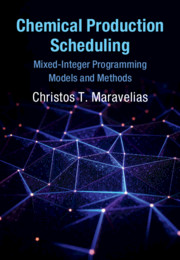Book contents
- Chemical Production Scheduling
- Cambridge Series in Chemical Engineering
- Chemical Production Scheduling
- Copyright page
- Dedication
- Contents
- Preface
- Part I Background
- Part II Basic Methods
- 3 Single-Unit Environment
- 4 Single-Stage Environment
- 5 Multistage Environment
- 6 Multipurpose Environment
- 7 Network Environment: Basics
- Part III Advanced Methods
- Part IV Special Topics
- Index
- References
6 - Multipurpose Environment
from Part II - Basic Methods
Published online by Cambridge University Press: 01 May 2021
- Chemical Production Scheduling
- Cambridge Series in Chemical Engineering
- Chemical Production Scheduling
- Copyright page
- Dedication
- Contents
- Preface
- Part I Background
- Part II Basic Methods
- 3 Single-Unit Environment
- 4 Single-Stage Environment
- 5 Multistage Environment
- 6 Multipurpose Environment
- 7 Network Environment: Basics
- Part III Advanced Methods
- Part IV Special Topics
- Index
- References
Summary
In this chapter, we discuss scheduling in multipurpose environments, which are the most general sequential environments. As in single- and multistage facilities, the general problem is posed in terms of facility (e.g., number and capacity of units) and product (e.g., processing times) data, as well as raw material and resource availability (e.g., batch release times), and product demand (e.g., due times). If the batching problem is solved independently, however, then the problem can be expressed in terms of batches instead of products. This is the problem that we study in the present chapter. Models for the simultaneous batching and scheduling can be formulated using the ideas presented in Chapter 4. General shared resources and storage policies can be modeled using the techniques presented in e Chapters 4 and 5, respectively.
- Type
- Chapter
- Information
- Chemical Production SchedulingMixed-Integer Programming Models and Methods, pp. 147 - 156Publisher: Cambridge University PressPrint publication year: 2021

